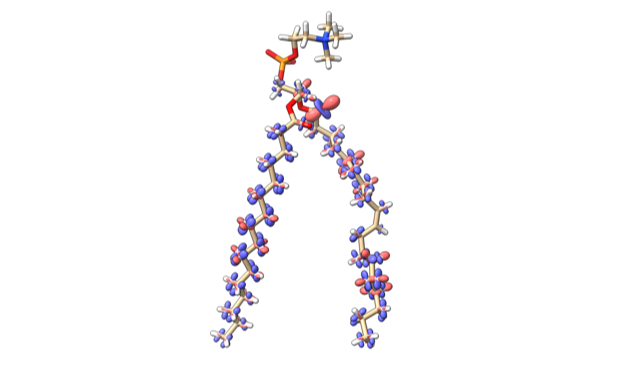ChimeraX Recipes
Making a Spherical Harmonic Surface
Here is some Python code when opened in ChimeraX creates spherical harmonic surfaces. Albert Smith asked about this. The real part of the spherical harmonic is depicted as the surface radius and colored red for positive radius and blue for negative radius.
r = Ylm(theta, phi)
where Ylm is a spherical harmonic, l = 2, m=0,1,2.

Python code ylm.py for ChimeraX 1.0:
# Make a spherical harmonic surface.
from math import sin, cos, pi, sqrt
def spherical_surface(session,
radius_function,
move = None, # a Place instance to rotate and translate surface
theta_steps = 100,
phi_steps = 50,
positive_color = (255,100,100,255), # red, green, blue, alpha, 0-255
negative_color = (100,100,255,255)):
# Compute vertices and vertex colors
vertices = []
colors = []
for t in range(theta_steps):
theta = (t/theta_steps) * 2*pi
ct, st = cos(theta), sin(theta)
for p in range(phi_steps):
phi = (p/(phi_steps-1)) * pi
cp, sp = cos(phi), sin(phi)
r = radius_function(theta, phi)
xyz = (r*sp*ct, r*sp*st, r*cp)
vertices.append(xyz)
color = positive_color if r >= 0 else negative_color
colors.append(color)
# Compute triangles, triples of vertex indices
triangles = []
for t in range(theta_steps):
for p in range(phi_steps-1):
i = t*phi_steps + p
t1 = (t+1)%theta_steps
i1 = t1*phi_steps + p
triangles.append((i,i+1,i1+1))
triangles.append((i,i1+1,i1))
# Create numpy arrays
from numpy import array, float32, uint8, int32
va = array(vertices, float32)
ca = array(colors, uint8)
ta = array(triangles, int32)
# Rotate and translate vertices to a new location.
if move is not None:
move.transform_points(va, in_place = True)
# Compute average vertex normal vectors
from chimerax.surface import calculate_vertex_normals
na = calculate_vertex_normals(va, ta)
# Create ChimeraX surface model
from chimerax.core.models import Surface
s = Surface('surface', session)
s.set_geometry(va, na, ta)
s.vertex_colors = ca
session.models.add([s])
return s
# Example spherical harmonic function Y(l=2,m=0) real part.
def y20_re(theta, phi):
return 0.25*sqrt(5/pi) * (3*cos(phi)**2 - 1)
def y21_re(theta, phi):
return -0.5*sqrt(15/(2*pi)) * sin(phi)*cos(phi) * cos(theta)
def y22_re(theta, phi):
return 0.25*sqrt(15/(2*pi)) * sin(phi)**2 * cos(2*theta)
from chimerax.geometry import translation
# Create 3 surfaces
spherical_surface(session, y20_re)
spherical_surface(session, y21_re, move = translation((1,0,0)) )
spherical_surface(session, y22_re, move = translation((2,0,0)) )
Combining surfaces into a single model
The above code could be modified to place several spherical harmonic surfaces in one model. The vertices, normals, triangles and colors for each surface can be combined into one with
geom = [(va1,na1,ta1,ca1), (va2,na2,ta2,ca2), ...]
from chimerax.surface import combine_geometry_vntc
va,na,ta,ca = combine_geometry_vntc(geom)
NMR dipole couplings
Albert Smith-Penzel used display of spherical harmonic surfaces to show NMR dipole-dipole interactions between bonded H and C atoms.

Tom Goddard, August 28, 2020